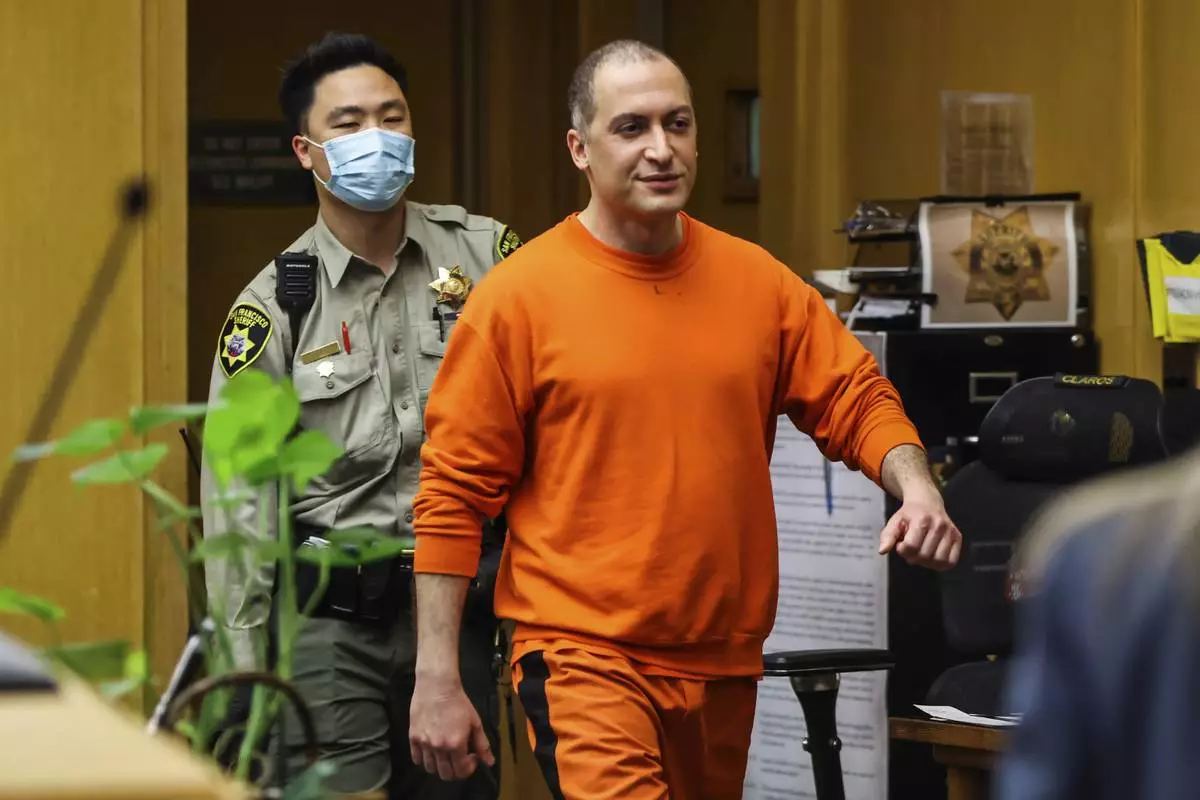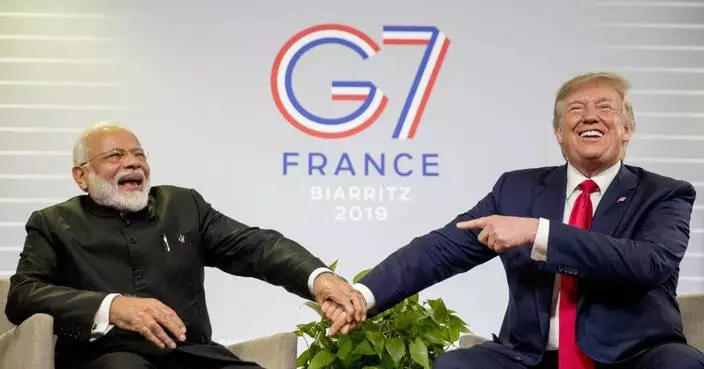SAN FRANCISCO (AP) — The tech consultant charged in Cash App founder Bob Lee 's stabbing death testified in his own defense Wednesday that he made a “bad joke” to try to put an end to a late night of drinking and doing drugs, and the famous entrepreneur suddenly attacked him.
In his first public statements about the events leading to Lee's death, Nima Momeni said that he joked to Lee that he might want to spend his final night in San Francisco with family rather than trying to find a strip club.
Momeni said Lee pulled out a knife and attacked him, forcing him to defend himself. He said Lee later walked away, showing no signs he was injured. Momeni said he called an attorney when he learned of Lee's death the following day.
“He’s a big famous guy,” he said. "I’m just an average joe, an immigrant.”
Lee, 43, was found staggering on a deserted downtown San Francisco street, dripping a trail of blood and calling for help. He later died at a hospital.
Prosecutors say Momeni, 40, planned the April 4, 2023, attack after a dispute over his younger sister, Khazar Momeni, with whom Lee was friends. They say Momeni took a knife from a unique set in his sister’s condo, drove Lee to a secluded area and stabbed him three times, then fled.
The defense says Lee was being erratic and aggressive, having slept only six hours over a four-day period of doing cocaine and ketamine and drinking.
Momeni has pleaded not guilty. He faces 26 years to life in prison if convicted.
But Momeni, who took the witness stand Wednesday, said the two men were on friendly terms when his sister kicked them both out of her condo at 2 a.m., saying she wanted to sleep after hours of partying and ingesting drugs.
Momeni said they got into his BMW and he started driving while Lee checked his phone for places to go next. He pulled the car over after they went over a pothole, causing Lee to spill his beer. Lee got out of the car and Momeni followed, thinking Lee was about to puke.
That was when he said he made the “bad joke” about seeing family.
“He just went from zero to 100,” Momeni said. “You could see the anger.”
Omid Talai, assistant district attorney, scoffed at the story on cross-examination Wednesday.
“He wanted to kill you over a bad joke?” said Talai, incredulous.
“I’m not sure why he pulled it out," Momeni said. “I was in fear for my life.”
Momeni pushed back Wednesday afternoon as Talai questioned him about text messages and testimony from others. The cross-examination continues Thursday.
Surveillance video of Lee’s final night shows him entering the posh Millennium Tower downtown, where Momeni’s sister lives with her husband, a prominent San Francisco plastic surgeon.
Video also shows Lee and Momeni leaving the building after 2 a.m. and driving off together in Momeni’s car. Grainy video also shows the two men getting out of the car in a isolated spot by the Bay Bridge.
Prosecutors say that is where Momeni stabbed Lee, while the defense says that is where Lee attacked Momeni.
Police recovered a knife with a 4-inch (10-centimeter) blade in the secluded area where Lee was stabbed. Prosecutors said tests showed Momeni’s DNA on the weapon’s handle and Lee’s DNA on the bloody blade, but the defense presented an expert witness who said the police should have tested the handle for fingerprints, namely Lee’s.
Lee’s death stunned the tech community as fellow executives and engineers penned tributes to the charismatic entrepreneur’s generosity and brilliance. Lee was chief product officer of cryptocurrency platform MobileCoin when he died. He was a father to two children.

FILE - Nima Momeni, the man charged in the fatal stabbing of Cash App founder Bob Lee, makes his way into the courtroom for his arraignment in San Francisco, May 2, 2023. (Gabrielle Lurie/San Francisco Chronicle via AP, Pool, File)
WASHINGTON (AP) — Those ever-present TV drug ads showing patients hiking, biking or enjoying a day at the beach could soon have a different look: New rules require drugmakers to be clearer and more direct when explaining their medications' risks and side effects.
The U.S. Food and Drug Administration spent more than 15 years crafting the guidelines, which are designed to do away with industry practices that downplay or distract viewers from risk information.
Many companies have already adopted the rules, which become binding Nov. 20. But while regulators were drafting them, a new trend emerged: thousands of pharma influencers pushing drugs online with little oversight. A new bill in Congress would compel the FDA to more aggressively police such promotions on social media platforms.
“Some people become very attached to social media influencers and ascribe to them credibility that, in some cases, they don’t deserve,” said Tony Cox, professor emeritus of marketing at Indiana University.
Still, TV remains the industry's primary advertising format, with over $4 billion spent in the past year, led by blockbuster drugs like weight-loss treatment Wegovy, according to ispot.tv, which tracks ads.
The new rules, which cover both TV and radio, instruct drugmakers to use simple, consumer-friendly language when describing their drugs, without medical jargon, distracting visuals or audio effects. A 2007 law directed the FDA to ensure that drug risk information appears “in a clear, conspicuous and neutral manner.”
FDA has always required that ads give a balanced picture of both benefits and risks, a requirement that gave rise to those long, rapid-fire lists of side effects parodied on shows like “ Saturday Night Live.”
But in the early 2000s, researchers began showing how companies could manipulate images and audio to de-emphasize safety information. In one example, a Duke University professor found that ads for the allergy drug Nasonex, which featured a buzzing bee voiced by Antonio Banderas, distracted viewers from listening to side effect information, making it harder to remember.
Such overt tactics have largely disappeared from drug ads.
“In general, I would say the ads have gotten more complete and transparent,” says Ruth Day, director of the medical cognition lab at Duke University and author of the Nasonex study.
The new rules are “significant steps forward,” Day said, but certain requirements could also open the door to new ways of downplaying risks.
One requirement instructs companies to show on-screen text about side effects while the audio information plays. A 2011 FDA study found that combining text with audio increased recall and understanding.
But the agency leaves it to companies to decide whether to display a few keywords or a full transcript.
“You often cannot put all that on the screen and expect people to read and understand it,” Day said. “If you wanted to hide or decrease the likelihood of people remembering risk information, that could be the way to do it.”
Viewers tend to tune out long lists of warnings and other information. But experts who work with drug companies don’t expect those lists to disappear. While the guidelines describe how the information should be presented, companies still decide the content.
“If you’re a company and you’re worried about possible FDA enforcement or product liability and other litigation, all your incentives are to say more, not less,” said Torrey Cope, a food and drug lawyer who advises companies.
Experts also say the new rules will have little effect on the overall tone and appearance of ads.
“The most salient element of these ads are the visuals, and they are uniformly positive,” said Cox. “Even if the risk message is about, for instance, sudden heart failure, they’re still showing someone diving into a swimming pool.”
The new rules come as Donald Trump's advisers begin floating plans for the FDA and the pharmaceutical industry.
Robert F. Kennedy Jr., an anti-vaccine activist who has advised the president-elect, wants to eliminate TV drug ads. He and other industry critics point out that the U.S. and New Zealand are the only countries where prescription drugs can be promoted on TV.
Even so, many companies are looking beyond TV and expanding into social media. They often partner with patient influencers who post about managing their conditions, new treatments or navigating the health system.
“They’re teaching people to live a good life with their disease, but then some of them are also paid to advertise and persuade,” said Erin Willis, who studies advertising and media at the University of Colorado Boulder.
Advertising executives say companies like the format because it’s cheaper than TV and consumers generally feel influencers are more trustworthy than companies.
FDA’s requirement for truthful, balanced risk and benefit information applies to drugmakers, leaving a loophole for both influencers and telehealth companies like Hims, Ro and Teledoc, who may not have a direct financial connection to makers of the drugs they’re promoting.
The issue has attracted attention from members of Congress.
“The power of social media and the deluge of misleading promotions has meant too many young people are receiving medical advice from influencers instead of their health care professional,” Sens. Dick Durbin of Illinois and Mike Braun of Indiana wrote the FDA in a February letter.
A recently introduced bill from the senators would bring influencers and telehealth companies clearly under FDA’s jurisdiction, requiring them to disclose risk and side effect information. The bill also would require drugmakers to publicly disclose payments to influencers.
“It’s asking the FDA to take a more serious stance with this kind of marketing,” said Willis. "They know it’s happening, but they could be doing more and their regulations haven’t been updated since 2014."
The Associated Press Health and Science Department receives support from the Howard Hughes Medical Institute’s Science and Educational Media Group. The AP is solely responsible for all content.

This combination of images from video shows scenes from Nasonex television commercials broadcast in the U.S. in the 2000s. (AP Photo)











